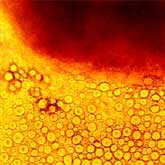Your Friend, the Fat Cell
 A healthy, adult human body contains about 35 billion fat cells. Each contains about 0.5 micrograms of fat. Stored fat is essential to good health. Fat is the body's principal energy reserve. It is used during long periods of exertion, such as running a marathon. It's also critical when food is in short supply, a situation that still faces most of the world's people today. Fat-storing tissue beneath the skin conserves body heat. It acts as a shock-absorbing, protective pad that protects body organs against injury. Fats contain the body's reserve of vitamins A, D, and E. Some of the substances stored in fat are growth factors. Others are essential for normal sexual development and reproduction.
A healthy, adult human body contains about 35 billion fat cells. Each contains about 0.5 micrograms of fat. Stored fat is essential to good health. Fat is the body's principal energy reserve. It is used during long periods of exertion, such as running a marathon. It's also critical when food is in short supply, a situation that still faces most of the world's people today. Fat-storing tissue beneath the skin conserves body heat. It acts as a shock-absorbing, protective pad that protects body organs against injury. Fats contain the body's reserve of vitamins A, D, and E. Some of the substances stored in fat are growth factors. Others are essential for normal sexual development and reproduction.
Humans must get at least six essential fatty acids from food, because the body cannot make them. Fat-containing foods such as nuts, peanut butter, and olive oil reduce the risk of heart disease. These foods contain plant sterols. The sterols are fat-like substances that interfere with absorption of artery-clogging cholesterol from foods. They also contain monounsaturated fatty acids. Among the other friends of the fat cell are the oily fish. The omega-3 fatty acids in fish oils lower cholesterol levels. Too few of them in the diet elevate the risks of heart disease, stroke, high blood pressure, rheumatoid arthritis, and inflammatory bowel disease. As few as two servings of salmon, tuna, anchovy, or sardines a week cuts the risk of sudden death from heart disease or stroke.
Fat cells are friends unless they grow too large in size and number. That's overweight or obesity. The only treatment is weight loss. Losing weight doesn't decrease the number of fat cells, but it does decrease their size. Fat loss isn't easy, but it's important for those who need it. Obesity is a major risk factor for diabetes, heart disease, high blood pressure, stroke, and cancer.
About the Author
Faith Brynie, Ph D
 Faith Brynie holds a B.A. in Biology from West Virginia University and an M.A. and Ph.D in science curriculum and instruction from the University of Colorado. She writes books and articles on science and health topics for children, teens, and non-scientist adults. Some of her books have won awards, including two 'Best Book of the Year' citations from the American Association for the Advancement of Science.
Faith Brynie holds a B.A. in Biology from West Virginia University and an M.A. and Ph.D in science curriculum and instruction from the University of Colorado. She writes books and articles on science and health topics for children, teens, and non-scientist adults. Some of her books have won awards, including two 'Best Book of the Year' citations from the American Association for the Advancement of Science.


